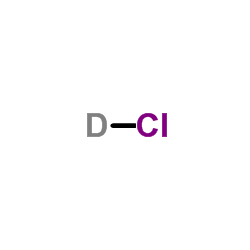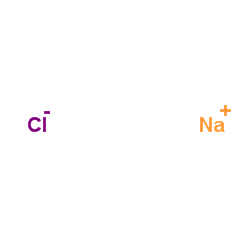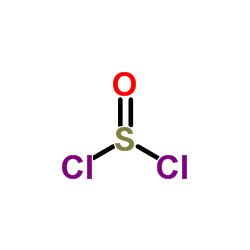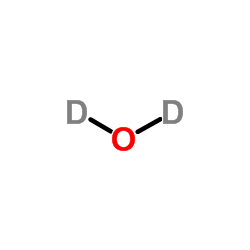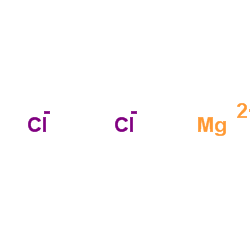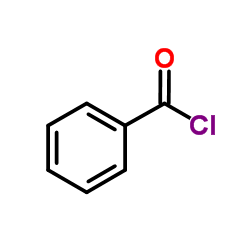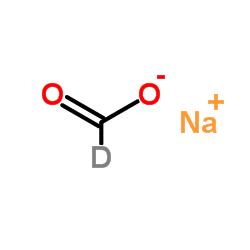7698-05-7
| 中文名 | 氘代盐酸 |
|---|---|
| 英文名 | Deuterium Chloride |
| 中文别名 |
盐酸-d1
盐酸-d 氯化氘 |
| 英文别名 |
MFCD00044642
deuterium chloride Hydrochloric acid-d (H)Hydrogen chloride EINECS 231-715-8 |
| 密度 | 1.2 |
|---|---|
| 沸点 | -84.9±9.0 °C at 760 mmHg |
| 熔点 | -114ºC(lit.) |
| 分子式 | ClD |
| 分子量 | 37.467 |
| 闪点 | −40 °F |
| 精确质量 | 36.982952 |
| LogP | 0.00 |
| 蒸汽密度 | 1.3 (vs air) |
| 蒸汽压 | 33917.9±0.1 mmHg at 25°C |
| 折射率 | n20/D 1.355 |
| 储存条件 | 2~8℃,干燥,密封 |
| 分子结构 | 1、摩尔折射率:无可用的 2、摩尔体积(cm3/mol):无可用的 3、等张比容(90.2K):无可用的 4、表面张力(dyne/cm):无可用的 5、介电常数:无可用的 6、极化率(10-24cm3):无可用的 7、单一同位素质量:36.982954 Da 8、标称质量:37 Da 9、平均质量:37.4671 Da |
Synonym:None Section 2 - COMPOSITION, INFORMATION ON INGREDIENTS
Risk Phrases: 25 35 Section 3 - HAZARDS IDENTIFICATION EMERGENCY OVERVIEW
Toxic if swallowed. Causes severe burns.Corrosive.Moisture sensitive. Potential Health Effects Eye: Causes eye burns. May cause chemical conjunctivitis and corneal damage. Skin: Causes skin burns. May cause skin rash (in milder cases), and cold and clammy skin with cyanosis or pale color. Ingestion: May cause severe and permanent damage to the digestive tract. May cause severe gastrointestinal tract irritation with nausea, vomiting and possible burns. May cause perforation of the digestive tract. The toxicological properties of this substance have not been fully investigated. May cause systemic effects. Inhalation: May cause irritation of the respiratory tract with burning pain in the nose and throat, coughing, wheezing, shortness of breath and pulmonary edema. Causes chemical burns to the respiratory tract. The toxicological properties of this substance have not been fully investigated. Aspiration may lead to pulmonary edema. May cause systemic effects. Chronic: Effects may be delayed. Section 4 - FIRST AID MEASURES Eyes: Get medical aid immediately. Do NOT allow victim to rub eyes or keep eyes closed. Extensive irrigation with water is required (at least 30 minutes). Skin: Get medical aid immediately. Immediately flush skin with plenty of water for at least 15 minutes while removing contaminated clothing and shoes. Wash clothing before reuse. Destroy contaminated shoes. Ingestion: Do not induce vomiting. If victim is conscious and alert, give 2-4 cupfuls of milk or water. Never give anything by mouth to an unconscious person. Get medical aid immediately. Inhalation: Get medical aid immediately. Remove from exposure and move to fresh air immediately. If not breathing, give artificial respiration. If breathing is difficult, give oxygen. Do NOT use mouth-to-mouth resuscitation. If breathing has ceased apply artificial respiration using oxygen and a suitable mechanical device such as a bag and a mask. Notes to Physician: Section 5 - FIRE FIGHTING MEASURES General Information: As in any fire, wear a self-contained breathing apparatus in pressure-demand, MSHA/NIOSH (approved or equivalent), and full protective gear. During a fire, irritating and highly toxic gases may be generated by thermal decomposition or combustion. Non-combustible, substance itself does not burn but may decompose upon heating to produce irritating, corrosive and/or toxic fumes. Extinguishing Media: Substance is noncombustible; use agent most appropriate to extinguish surrounding fire. Section 6 - ACCIDENTAL RELEASE MEASURES General Information: Use proper personal protective equipment as indicated in Section 8. Spills/Leaks: Absorb spill with inert material (e.g. vermiculite, sand or earth), then place in suitable container. Avoid runoff into storm sewers and ditches which lead to waterways. Clean up spills immediately, observing precautions in the Protective Equipment section. Provide ventilation. Section 7 - HANDLING and STORAGE Handling: Wash thoroughly after handling. Wash hands before eating. Use only in a well-ventilated area. Do not breathe dust, vapor, mist, or gas. Do not get in eyes, on skin, or on clothing. Keep container tightly closed. Do not ingest or inhale. Discard contaminated shoes. Storage: Store in a cool, dry place. Keep container closed when not in use. Corrosives area. Section 8 - EXPOSURE CONTROLS, PERSONAL PROTECTION Engineering Controls: Facilities storing or utilizing this material should be equipped with an eyewash facility and a safety shower. Use adequate ventilation to keep airborne concentrations low. Exposure Limits CAS# 7698-05-7: CAS# 7789-20-0: Personal Protective Equipment Eyes: Wear appropriate protective eyeglasses or chemical safety goggles as described by OSHA's eye and face protection regulations in 29 CFR 1910.133 or European Standard EN166. Skin: Wear appropriate protective gloves to prevent skin exposure. Clothing: Wear appropriate protective clothing to prevent skin exposure. Respirators: A respiratory protection program that meets OSHA's 29 CFR 1910.134 and ANSI Z88.2 requirements or European Standard EN 149 must be followed whenever workplace conditions warrant respirator use. Section 9 - PHYSICAL AND CHEMICAL PROPERTIES Physical State: Liquid Color: clear, colorless Odor: chlorine-like pH: <2.0 Vapor Pressure: Not available. Viscosity: Not available. Boiling Point: 108 deg C @ 760.00mm Hg Freezing/Melting Point: Not available. Autoignition Temperature: Not applicable. Flash Point: Not applicable. Explosion Limits, lower: Not available. Explosion Limits, upper: Not available. Decomposition Temperature: Solubility in water: Soluble. Specific Gravity/Density: >1.000 Molecular Formula: Solution Molecular Weight: 0 Section 10 - STABILITY AND REACTIVITY Chemical Stability: Stable under normal temperatures and pressures. Conditions to Avoid: Incompatible materials, dust generation, moisture, excess heat. Incompatibilities with Other Materials: Strong bases. Hazardous Decomposition Products: Hydrogen chloride, irritating and toxic fumes and gases. Hazardous Polymerization: Has not been reported. Section 11 - TOXICOLOGICAL INFORMATION RTECS#: CAS# 7698-05-7 unlisted. CAS# 7789-20-0: ZC0230000 LD50/LC50: Not available. Not available. Carcinogenicity: Deuterium Chloride - Not listed by ACGIH, IARC, or NTP. Deuterium Oxide - Not listed by ACGIH, IARC, or NTP. Other: See actual entry in RTECS for complete information. Section 12 - ECOLOGICAL INFORMATION Section 13 - DISPOSAL CONSIDERATIONS Dispose of in a manner consistent with federal, state, and local regulations. Section 14 - TRANSPORT INFORMATION IATA Shipping Name: HYDROCHLORIC ACID Hazard Class: 8 UN Number: 1789 Packing Group: II IMO Shipping Name: HYDROCHLORIC ACID Hazard Class: 8 UN Number: 1789 Packing Group: II RID/ADR Shipping Name: HYDROCHLORIC ACID Hazard Class: 8 UN Number: 1789 Packing group: II Section 15 - REGULATORY INFORMATION European/International Regulations European Labeling in Accordance with EC Directives Hazard Symbols: T C Risk Phrases: R 25 Toxic if swallowed. R 35 Causes severe burns. Safety Phrases: S 9 Keep container in a well-ventilated place. S 26 In case of contact with eyes, rinse immediately with plenty of water and seek medical advice. S 36/37/39 Wear suitable protective clothing, gloves and eye/face protection. S 45 In case of accident or if you feel unwell, seek medical advice immediately (show the label where possible). WGK (Water Danger/Protection) CAS# 7698-05-7: No information available. CAS# 7789-20-0: No information available. Canada CAS# 7789-20-0 is listed on Canada's DSL List. CAS# 7698-05-7 is not listed on Canada's Ingredient Disclosure List. CAS# 7789-20-0 is not listed on Canada's Ingredient Disclosure List. US FEDERAL TSCA CAS# 7698-05-7 is not listed on the TSCA inventory. It is for research and development use only. CAS# 7789-20-0 is listed on the TSCA inventory. SECTION 16 - ADDITIONAL INFORMATION N/A |
|
生态学数据: 对水是稍微危害的,若无政府许可,勿将材料排入周围环境。
|
| 符号 |



GHS04, GHS05, GHS06 |
|---|---|
| 信号词 | Danger |
| 危害声明 | H280-H314-H331 |
| 补充危害声明 | May form explosive peroxides. |
| 警示性声明 | P261-P280-P303 + P361 + P353-P304 + P340 + P310-P305 + P351 + P338-P403 + P233 |
| 危害码 (欧洲) | Xi:Irritant; |
| 风险声明 (欧洲) | R36/37/38 |
| 安全声明 (欧洲) | S26-S45 |
| 危险品运输编码 | UN 2924 3/PG 1 |
| WGK德国 | 3 |
| 包装等级 | II |
| 上游产品 10 | |
|---|---|
| 下游产品 9 | |


